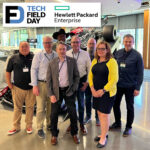|
|
This video is part of the appearance, “HPE ProLiant Portfolio Overview“. It was recorded as part of Next Gen HPE ProLiant Compute Deep Dive at 09:00-09:30 on April 8, 2025.
Watch on YouTube
Watch on Vimeo
In this presentation, Darren Anthony highlights the long-standing innovation and evolution of the HPE ProLiant server platform, beginning with its debut in 1993. He traces the portfolio’s development through key milestones such as the introduction of four-processor blades in 2003, Gen 8 in 2012, Silicon Root of Trust in 2017, and Gen 11 in 2022. The newly launched Gen 12 servers build upon this legacy with significant advancements in security, performance, and efficiency, reaffirming HPE’s commitment to innovation in the face of evolving IT workloads and security threats.
A major feature of Gen 12 servers is the enhanced Integrated Lights-Out (iLO) 7 management processor, built upon HPE’s proprietary 64-bit ASIC. This includes a new secure enclave, effectively a hardware-based security module akin to a TPM, which provides tamper protection and cryptographic storage. These enhancements are HPE’s response to growing concerns from customers about hardware and supply chain security, especially as threats such as quantum computing become more prominent. The secure supply chain initiatives ensure server integrity from the factory floor to customer delivery, providing confidence to CISOs and infrastructure leaders alike.
Beyond security, Gen 12 also addresses modern application demands by supporting increasingly dense configurations and emerging workloads, such as AI and high-performance computing. Anthony discusses the challenges of thermal management as components grow more power-hungry, and notes HPE’s readiness for liquid cooling, calling back to decades of IP in this space. With support for advanced accelerators and collaboration with partners like NVIDIA and Intel, the Gen 12 lineup includes flexible platforms for edge, SMB, enterprise, and AI environments. This broad portfolio underscores HPE’s agility to meet a variety of workload needs while remaining forward-looking in compute infrastructure design.
Personnel: Darren Anthnoy









